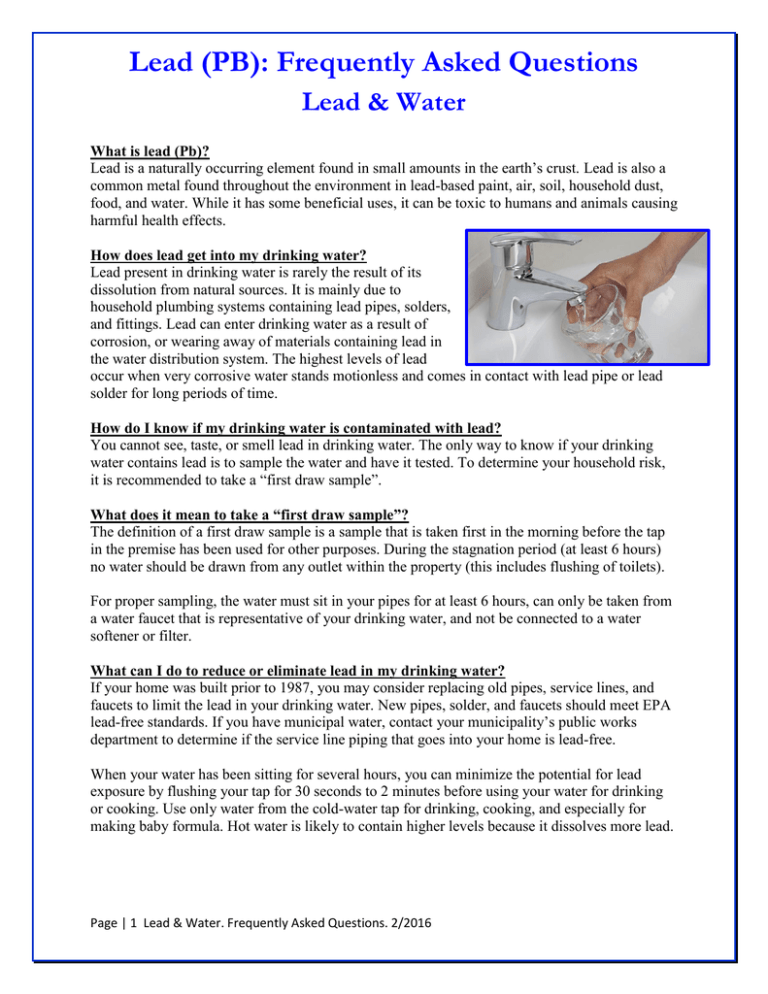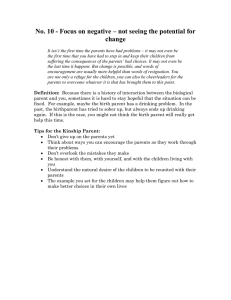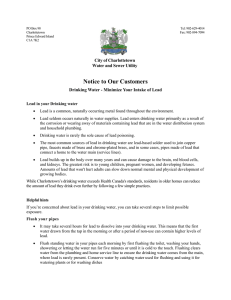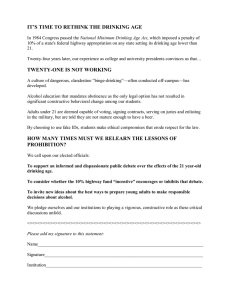Lead (PB): Frequently Asked Questions
advertisement

Lead (PB): Frequently Asked Questions Lead & Water What is lead (Pb)? Lead is a naturally occurring element found in small amounts in the earth’s crust. Lead is also a common metal found throughout the environment in lead-based paint, air, soil, household dust, food, and water. While it has some beneficial uses, it can be toxic to humans and animals causing harmful health effects. How does lead get into my drinking water? Lead present in drinking water is rarely the result of its dissolution from natural sources. It is mainly due to household plumbing systems containing lead pipes, solders, and fittings. Lead can enter drinking water as a result of corrosion, or wearing away of materials containing lead in the water distribution system. The highest levels of lead occur when very corrosive water stands motionless and comes in contact with lead pipe or lead solder for long periods of time. How do I know if my drinking water is contaminated with lead? You cannot see, taste, or smell lead in drinking water. The only way to know if your drinking water contains lead is to sample the water and have it tested. To determine your household risk, it is recommended to take a “first draw sample”. What does it mean to take a “first draw sample”? The definition of a first draw sample is a sample that is taken first in the morning before the tap in the premise has been used for other purposes. During the stagnation period (at least 6 hours) no water should be drawn from any outlet within the property (this includes flushing of toilets). For proper sampling, the water must sit in your pipes for at least 6 hours, can only be taken from a water faucet that is representative of your drinking water, and not be connected to a water softener or filter. What can I do to reduce or eliminate lead in my drinking water? If your home was built prior to 1987, you may consider replacing old pipes, service lines, and faucets to limit the lead in your drinking water. New pipes, solder, and faucets should meet EPA lead-free standards. If you have municipal water, contact your municipality’s public works department to determine if the service line piping that goes into your home is lead-free. When your water has been sitting for several hours, you can minimize the potential for lead exposure by flushing your tap for 30 seconds to 2 minutes before using your water for drinking or cooking. Use only water from the cold-water tap for drinking, cooking, and especially for making baby formula. Hot water is likely to contain higher levels because it dissolves more lead. Page | 1 Lead & Water. Frequently Asked Questions. 2/2016 You may choose to install a water filter that is NSF-certified for lead removal. If a water filter is installed, replace filters at least as often as recommended by the manufacturer. If a filter is installed and utilized, sampling is still recommended to assure water quality. When was lead prohibited from use in plumbing and plumbing fixtures? Section 1417 of the Safe Drinking Water Act (SDWA) prohibits the “use of any pipe, any pipe or plumbing fitting or fixture, any solder, or any flux, after June 1986, in the installation or repair of (i) any public water system; or (ii) any plumbing in a residential or non-residential facility providing water for human consumption, that is not lead free.” Additionally, the SDWA also prohibits introducing a pipe, any pipe or plumbing fitting or fixture, any solder, or any flux that is not lead free into commerce; unless the use is for manufacturing or industrial purposes. The SDWA includes several exemptions from the lead free requirements, specifically for plumbing devices that are used exclusively for non-potable services, as well as a list of specific products: toilets, bidets, urinals, fill valves, flushometer valves, fire hydrants, tub fillers, shower valves, service saddles, or water distribution main gate valves that are 2 inches in diameter or larger. Who do I contact for more information on lead and water testing? If you are on municipal water, the municipality or management of the mobile home park / apartment complex should be the first place to start. City of Kalamazoo – 269-337-8440 o http://www.kalamazoocity.org/departments/public-services/water City of Portage – 269-329-4422 o http://www.portagemi.gov/Departments/TransportationUtilities.aspx City of Parchment – 269-344-6400 o http://www.parchment.org/utilities/ City of Galesburg – 269-665-7213 o http://www.galesburgcity.org/index.html For the following jurisdictions, contact the public works / water department. o Charleston Township – 269-665-7805 o Village of Augusta – 269-731-4717 o Village of Climax – 269-746-4174 o Village of Schoolcraft – 269-679-4304 o Village of Vicksburg – 269-649-1919 For the following apartment complexes / mobile home communities / other community water supplies, contact management. o Alamo Nursing Home – 269-343-2587 o Andrews Estates – 269-665-9122 o Boerman Mobile Village – Unknown Number o Climax Mobile Home Park – 269-746-4484 o Evergreen Park – 269-342-5496 o Kellogg Biological Station – 269-671-5117 o Nazarene Camp – 269-649-2281 o Plainwell Pines – 269-349-6649 o Portage Terrace – 269-327-2093 Page | 2 Lead & Water. Frequently Asked Questions. 2/2016 o Royal Estates – 269-349-5350 o Sugarloaf Mobile Home Park – 269-679-5087 o Sun Meadows Apartments – 269-649-0211 All municipal water supplies are required to comply with the Consumer Confidence Report (CCR) Rule, which requires community water supplies to annually report to their customers on the quality of the drinking water and the sources of that water, and to characterize the risks (if any) from exposure to contaminants detected in the water. To obtain a copy of this report, contact your municipal water supplier. If you are on a private water well, contact the Kalamazoo County Health & Community Services Department at 269-373-5336. What can I do if I am connected to a private, residential water well? Homes built before 1987 are more likely to have pipes, fittings, faucets, and solder that contain lead. Additionally, depending on the age of your water well, a lead packer may have been installed. Contact Environmental Health at 269-373-5336 to discuss sample recommendations and costs. Where do I go for more information? The United States Environmental Protection Agency provides information about drinking water and ground water programs authorized under the Safe Drinking Water Act. You can contact the Safe Drinking Water Hotline at 1-800-426-4791 or go to http://www.epa.gov/your-drinkingwater/safe-drinking-water-hotline to ask an online question. Page | 3 Lead & Water. Frequently Asked Questions. 2/2016






